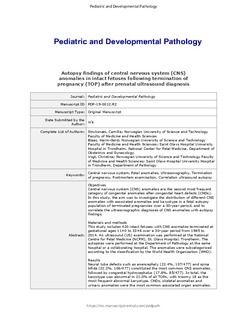| dc.description.abstract | Objectives
Central nervous system (CNS) anomalies are the second most frequent category of congenital anomalies after congenital heart defects (CHDs). In this study, the aim was to investigate the distribution of different CNS anomalies with associated anomalies and karyotype in a fetal autopsy population of terminated pregnancies over a 30-year period and to correlate the ultrasonographic diagnoses of CNS anomalies with autopsy findings.
Materials and Methods
This study includes 420 intact fetuses with CNS anomalies terminated at gestational ages 11+ 0 to 33+ 6 over a 30-year period from 1985 to 2014. An ultrasound (US) examination was performed at the National Centre for Fetal Medicine, St. Olavs Hospital, Trondheim. The autopsies were performed at the Department of Pathology at the same hospital or a collaborating hospital. The anomalies were subcategorized according to the classification by the World Health Organization.
Results
Neural tube defects such as anencephaly (22.4%, 107/477) and spina bifida (22.2%, 106/477) constituted the most common CNS anomalies, followed by congenital hydrocephalus (17.8%, 85/477). In total, the karyotype was abnormal in 21.0% of all termination of pregnancies (TOPs), with trisomy 18 as the most frequent abnormal karyotype. CHDs, skeletal anomalies, and urinary anomalies were the most common associated organ anomalies. Throughout the study period, there was full agreement between US and postmortem findings of CNS anomalies in 96.9% (407/420) of TOPs.
Conclusion
In this study of autopsy findings of CNS anomalies in intact fetuses terminated after prenatal US diagnosis, neural tube defects were most common. About half of the fetuses had isolated serious CNS anomalies, while the other half were CNS anomalies associated with structural and/or chromosomal anomalies. The prenatal US diagnoses were in good concordance with autopsy findings. In particular, due to challenges of diagnoses made early in pregnancy, it is necessary to continue the validation practice. | nb_NO |
